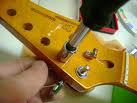Adjusting your guitar Tuning Heads/machines is another excellent way of keeping your guitar in tune. This is part of my ongoing series of posts that highlight how to troubleshoot what you can do to keep your guitar strings in tune and for good overall guitar maintenance.
Over the lifespan of your guitar, the tuning heads will vibrate and loose that snug fit they once had when they were brand new. This could be caused by many factors. For example putting your guitar into it’s case and carrying it around or accidentally dropping it from time to time could cause the tuning heads to loosen.
Just a side note here, one time I ran over my very old acoustic with my car! When I reluctantly opened it, it was fine and still in tune. Another great reason why you should always purchase a very strong guitar case!
One of the easiest way of rectifying the problem of loose tuning heads is by bringing out a pocket-sized screw driver, either a Flathead or a Philips will do, and tightening the screws that hold the tuning heads to the head stock. Sometimes companies use a hexagonal socket set or wrench. The most common size is 7/16 – 10 mm.
First tighten the Tuning Head mounting screws on the back of the headstock with your screwdriver, this is fairly simple. Remember righty tighty and lefty loosy! Now we can turn our attention to the front of the headstock.
 This is when we bring out our socket or wrench set. By glancing down directly at it, locate the bolt which is on top of the grommet or washer at the base of the peg post on the front of the headstock. Now with either the wrench or socket set, find the right sized one that will fit tightly on the bolt. Here we will turn your tool very carefully to right. DO NOT OVER TIGHTEN. To make things easy for you, remove the string that you are working on first.
This is when we bring out our socket or wrench set. By glancing down directly at it, locate the bolt which is on top of the grommet or washer at the base of the peg post on the front of the headstock. Now with either the wrench or socket set, find the right sized one that will fit tightly on the bolt. Here we will turn your tool very carefully to right. DO NOT OVER TIGHTEN. To make things easy for you, remove the string that you are working on first.
You may have completely different tuning heads then the ones that I have just covered. Some tuners may be adjusted by just pushing the grommets back into place. Once again, remove the string that you are working on first. If there is only one loose, then you might as well take the time to check the other ones while your at it.
If you’ve attempted to adjust your tuners and your instrument is still going out of tune too frequently, then maybe you should replace them all together. I have never ventured into doing this before so it maybe wise to contact your local luthier for advice on this one.
If you have a head stock that is made of wood, it sometimes shrinks and cracks due to lack of proper humidity inside the guitar case. This is a fantastic reason to get a acoustic guitar Dampits for your acoustic or classical guitar! It’s also a great gift you someone. I strongly insist that you purchase this product. It helps keep the humidity levels just right so that the wood on your acoustic guitar stays intact.
I hope this post has cleared up any questions that you may have about this very common topic and hope that you find it useful.
Keep on Jammin’
Cheers mate. Exactly the post I was looking for – my D string tuning head has become a bit loose and I needed to tighten it. I had no idea what to do until I read this piece, so I’m delighted I found your blog!
Graeme Davidson
I really glad to have helped you out Graeme. PLEASE tell us how it went and if you can, tell us what steps that you think could be added to help other guitarist out in their struggle to adjust a tuning head!
Best of luck my friend.